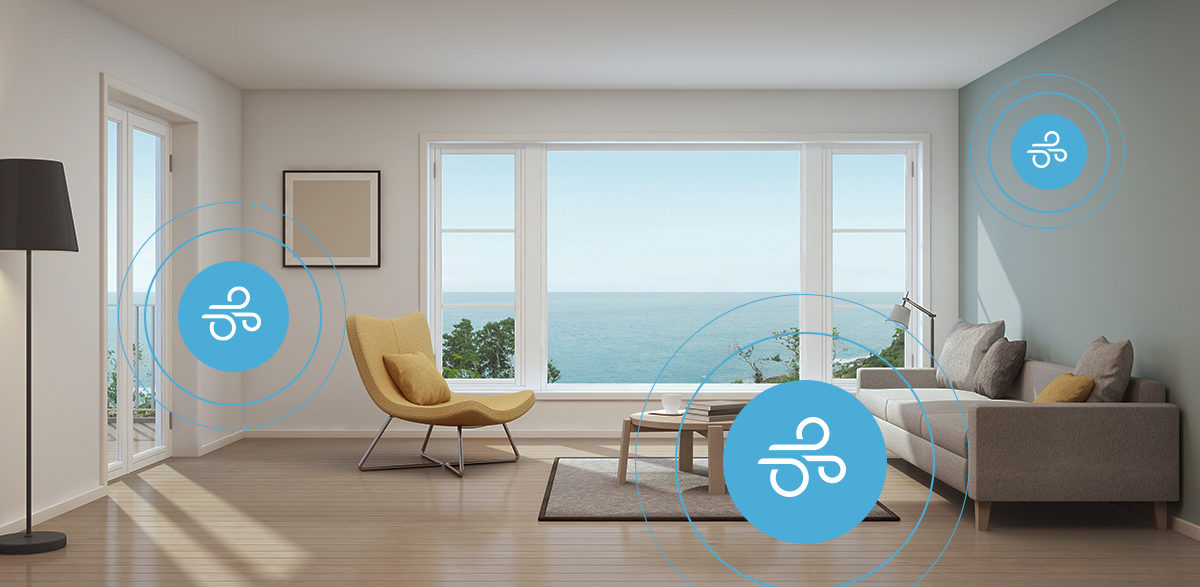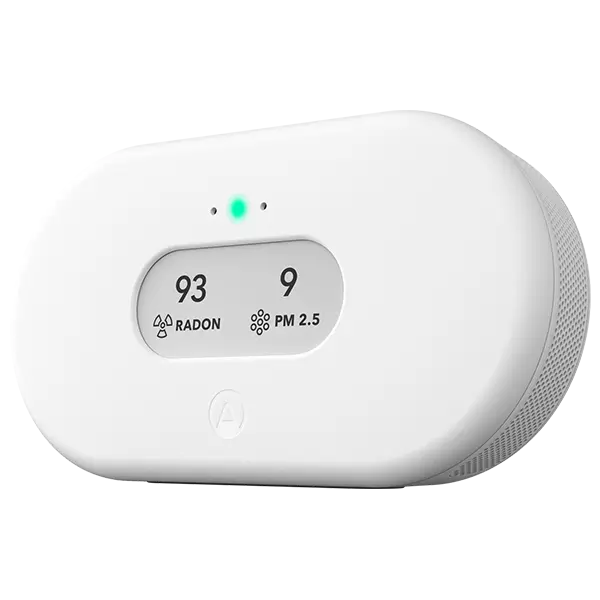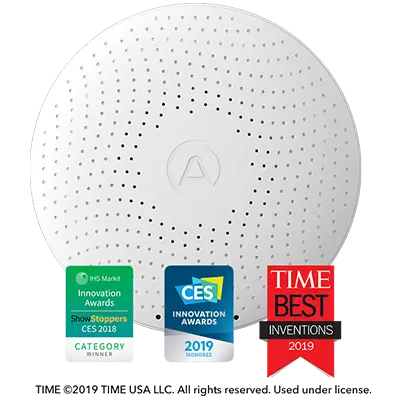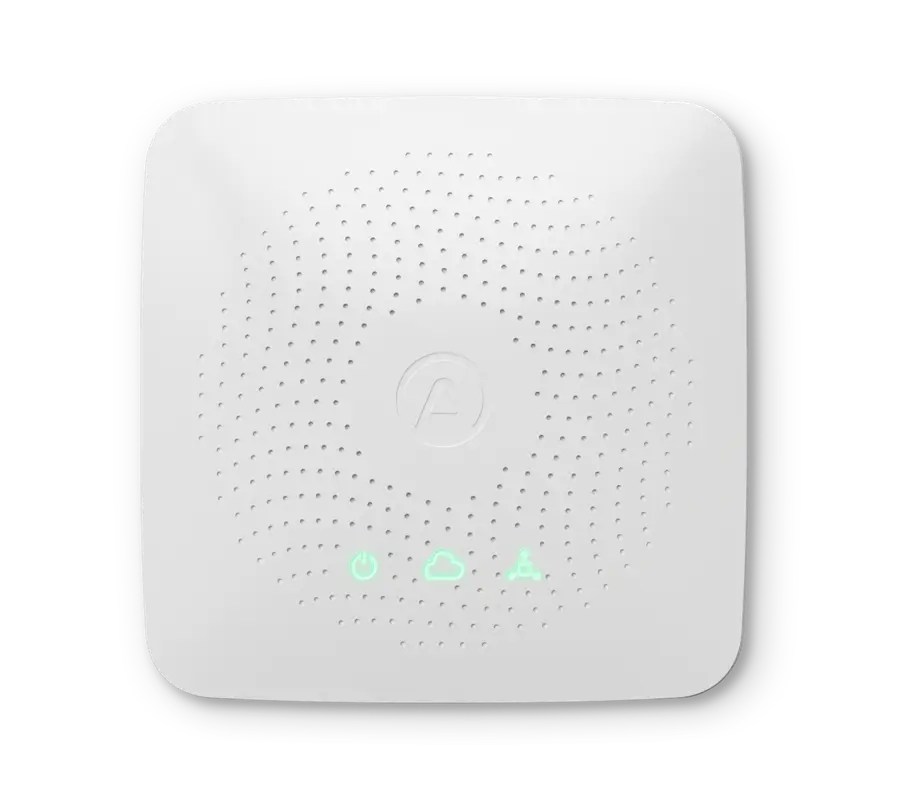Airthings offers comprehensive indoor air quality monitoring for homes, businesses, schools and more, but do you know what we monitor in the air?
Given that we spend 90% of our time indoors, it can't be underestimated just how crucial Indoor air quality (IAQ) is to our health and well-being. The quality of the air we breathe indoors can impact our physical and mental health even more so than outdoor air, especially in the long run. That's why the pollutants and factors which can negatively impact us are specifically monitored by sensors within Airthings products. Amongst our range of indoor air quality monitors, you can detect carbon dioxide (CO2), volatile organic compounds (VOCs), radon, particulate matter (PM2.5, PM1), air pressure, temperature, humidity, and mold risk. As you would imagine, there's very specific reasons why we monitor what we do and why we've chosen certain methods to detect what's in the air you breathe as accurately as possible. This blog post will outline which sensors are used in Airthings products. 
Carbon dioxide (CO2)
Carbon dioxide (CO2) is a natural component of the air, and all humans exhale it with every breath. However, when the CO2 levels in indoor air exceed the recommended levels, it can cause headaches, dizziness, and fatigue. Therefore, monitoring the CO2 levels in indoor air is crucial to maintain a healthy indoor environment. Additionally, high CO2 levels can be an indicator of poor ventilation, which can lead to the build-up of other more dangerous indoor pollutants.
Why we chose our CO2 sensor: Airthings uses NDIR (Non-Dispersive Infra-Red) sensors to measure the amount of CO2 gas molecules present in the air. This technology is considered to be the most effective and precise for measuring CO2 levels in indoor environments and is superior to catalytic bead sensors. NDIR sensors do not burn out even when exposed to high concentrations of gasses and are automatically calibrated (using the automated background calibration algorithm). NDIR sensors also have a fail-safe so that inoperable sensors can be detected. The NDIR sensor works by shining an infrared light on a sensor at one end of a chamber, which samples air from the room it is placed in. As the light passes through the chamber, only CO2 is absorbed, and the sensor measures how much light has passed through the chamber, excluding the CO2 molecules. This provides an extremely accurate result of exactly how much CO2 is present in the air. The sensor actively counts the molecules every five minutes to ensure that the most up-to-date statistics are provided.
Notably, there is another supposed method of monitoring CO2 called eCO2 which is not used by Airthings. Unfortunately, this commonly seen acronym, can be highly inaccurate and confuse consumers as to what their devices are actually monitoring. An eCO2 estimate usually comes from a metal oxide TVOC sensor and not a dedicated CO2 sensor. Thus you'll often see when a monitor is measuring VOCs it also claims to be able to measure CO2. These sensors generate the estimated value by measuring the resistance of a special reactive layer that is exposed to the air being measured. However, they can be easily worn down by exposure to gasses and has a cross-sensitivity to other gases meaning there is often no direct correlation between increased CO2 and eCO2 levels. Finally, eCO2 sensors are considerably cheaper than the NDIR sensor, and as previously alluded to they only produce a highly estimated value, hence the 'e'.
Overall, Airthings' use of NDIR sensors ensures accurate and reliable measurements of indoor CO2 levels, which is essential for maintaining healthy indoor air quality and preventing negative health effects associated with high levels of CO2.
Airthings products that monitor CO2:
View Plus, Wave Plus, Wave Plus - Limited Edition Black
Volatile Organic Compounds (VOCs)
Volatile organic compounds (VOCs) are chemicals that can evaporate and easily become airborne. They are emitted from various sources, such as cleaning products, building materials, and furniture. Exposure to high levels of VOCs can irritate the eyes, nose, and throat, as well as headaches, dizziness, and other health problems. Therefore, monitoring the VOC levels in indoor air is essential to reduce the risk of health problems.
Why we chose our sensor: Airthings employs a TVOC (Total Volatile Organic Compounds) sensor in our products which works via a metal-oxide based sensor with a sensitive layer that reacts to chemicals by adsorption. The volume of gas per classification and the sum of all gasses (TVOC) are important reflections of the relevant organic compounds found in indoor air. So it's important to have a sensor which monitors as full a spectrum as possible of potential gasses in the air.
Airthings products that monitor VOC:
View Plus, Wave Plus, Wave Plus - Limited Edition Black, Wave Mini
Radon
Radon is a colorless and odorless gas that is naturally present in the soil and can seep into homes through cracks in the foundation. Long-term exposure to high levels of radon can increase the risk of lung cancer according to the EPA. Therefore, monitoring radon levels in indoor air is crucial to identify and address any potential risks.
Why we chose our sensor: Airthings holds no less than three patents for Radon detection. As a company founded by particle physicists specializing in radiation, we have been the industry leader in consumer Radon detection for over a decade. In 2016, EPA Ireland conducted a 4-week intercomparison study between radon measurement devices. Among the tested units were Atmos 12 dpx, RAD7, RStone, Sun Nuclear 1028, Ramon 2.2, Airthings Corentium Home (Canary), and CR-39. Corentium Home performed excellently in this independent study. After 4 weeks of testing, Corentium Home was within ± 10% of the actual radon level which was determined by a professional device with a retail price in the thousands. Corentium Home was the number one recommended low-cost and long-term radon testing device in the study. Since 2008, Airthings has made it our mission to educate consumers of the importance of long-term monitoring and provide them with the reliable tools to do so. This is because most people that do know a little about radon think that charcoal pots are the gold standard of radon measurement. However these tests only provide a one time only snapshot of the true radon level and thus have been shown to be far less reliable than digital radon detection as well as this the charcoal test fails to alert you of any issues in the future.
Airthings products that monitor radon:
View Plus, View Radon, Wave Plus, Wave Plus - Limited Edition Black, Wave Radon, Corentium Home
Particulate Matter (PM)
Particulate matter (PM) refers to tiny particles that are suspended in the air, such as dust, pollen, and smoke or smog. When the term "air pollution is used, it is often referring to the PM in the air. Unfortunately, exposure to high levels of PM can cause respiratory problems, such as asthma and bronchitis, and can also lead to cardiovascular disease as they tiny particles such as PM2.5 are small enough to enter your bloodstream. Studies suggest that PM levels currently present in the earths air are responsible for reducing the global life expectancy by as much as 2.2 years, costing millions their lives every single year. This is in comparison to a world which met the WHO guidelines for safe and breathable air. So, monitoring the PM levels in indoor air is integral to reducing the risk of health complications and mortality.
Why we chose our sensor:
Airthings products use a laser scattering-based optical particle counter. As the name says, it uses a laser to detect and count both small and large particles floating in the air. This type of sensor is extremely accurate which is especially important since PM measurements are often used to trigger the operation of air purifiers and homes or building filtration systems.
Airthings products that monitor PM:
View Plus, View Pollution
Air Pressure
Most notably air pressure can affect the circulation of air within a building, which can impact IAQ. Monitoring air pressure levels can help identify any issues with a home or building's ventilation system, which of course can impact the overall IAQ. While sometimes overlooked by consumer air quality monitors, air pressure can not only affect comfort but also other air quality factors too. Additionally changes in air pressure affect radon levels and, for some, they can trigger headaches, joint stiffness, and pain.
Airthings products that monitor air pressure:
View Plus
Temperature
While temperature is most often a matter of preference and the most easily detected aspect of IAQ, it can have other adverse effects on the quality of the air you breathe. Temperature can impact the growth and spread of microorganisms, such as mold and bacteria. Additionally, monitoring temperature when you're outside of your home or asleep can inform you whether your conditions are optimal or if you're wasting energy by overheating your home.
Airthings products with Temperature sensors:
View Plus, Wave Plus, Wave Plus - Limited Edition Black, Wave Mini, Wave Radon
Humidity
Similarly, low humidity levels are often linked to temperature and can combine to impact the growth and spread of microorganisms, such as mold and bacteria. Conversely, low humidity levels can cause dry skin and the exacerbation of other respiratory problems.
Airthings products that monitor humidity:
View Plus, Wave Plus, Wave Plus - Limited Edition Black, Wave Mini, Wave Radon
Mold risk
Mold can be bad for air quality for several reasons. First, mold spores are tiny particles that can become airborne and spread throughout a building, especially in areas with high humidity or moisture. When mold spores are inhaled, they can cause a range of health problems, including respiratory issues, allergies, and asthma. Mold growth can also produce harmful VOCs and can even weaken the structural integrity of a building.
Why we chose our sensor: That's why Airthings developed the mold risk indicator because when you see mold, it's too late. This virtual sensor measures temperature and humidity in the air to detect and monitor the risk of mold growth before it actually happens. Precisely, it calculates the dew point and alerts users if conditions are conducive to mold growth. To use the Wave Mini properly as a mold risk indicator, the monitor must be placed right where you suspect that mold might grow. Bathrooms, basements, attics, cabins, kitchens, are all reasonable places to expect mold could appear. Finally, due to the high humidity conditions expected around the Wave Mini when using the product as a mold risk indicator, CO2, radon, and PM sensors were not added as they can't handle the highly humid conditions.
Airthings products that monitor for mold risk:
Wave Mini 
By monitoring the aspects mentioned above, individuals can identify and address almost any potential risks to their health and well-being occurring within their home.












%20(1).webp)

%20(1).webp)
